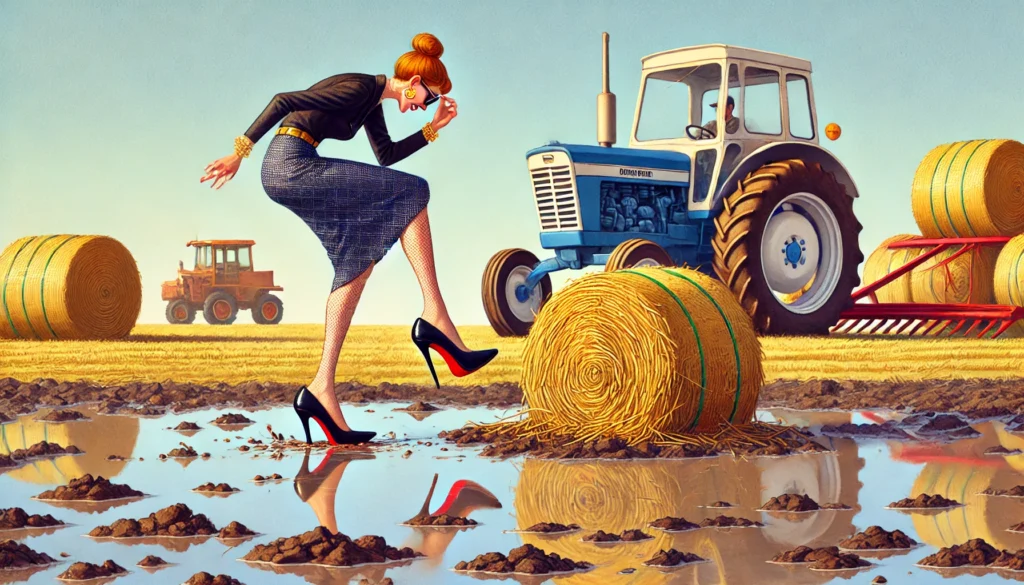
Fancy on the Farm A satirical single frame illustration showing a woman in high heels struggling as her stilettos sink deep into the mud near a pile of hay bales. The s5.webp.webp
From silk ties getting acquainted with tractor grease to a curious pig treating your bowtie as an hors d’oeuvre, we’ve collected firsthand stories from folks who thought they could out-style the barnyard. Spoiler alert: the barn won.
High Heels and Hay Bales: Janine Simmons’ Fashion Faux Pas
When Janine Simmons, a public relations executive from Dallas, stepped onto the farm in four-inch heels, she quickly found herself sinking faster than a bad press release. “I didn’t think the ground would be that soft. But one step off the gravel, and those heels became stakes in the mud. By the time I got to the barn, I had to ditch them. I walked in barefoot, and the goats started chewing on my heels like they were treats.”
Witnesses chuckled as they recalled Janine hobbling toward the barn with a pair of designer heels dangling from her hands. “She was trying to balance on her tiptoes at first, but the mud was winning,” said Tom Harper, a longtime farmhand. “It was a losing battle from the start.”
Silk Ties and Tractor Grease: Pete’s Slippery Situation
In what may be one of the least surprising developments on a farm, Pete, a banker from Houston, learned that silk ties and heavy machinery don’t mix. “I thought I could wear my tie while helping out on the farm,” Pete said, his voice filled with regret. “I was reaching for an egg, and somehow, the tie dipped into a puddle of tractor grease. It was like a slow-motion disaster.”
Agricultural engineer Don Wilson wasn’t shocked: “Silk is about the worst material you can wear near anything mechanical. Farm life doesn’t accommodate delicate fabrics.” Pete’s tie, once a gleaming symbol of urban sophistication, now resembles modern art—if modern art involved a lot of oil.

Barbed Wire vs. Tuxedos: Charlie Westwood’s Brush with Disaster
For Charlie Westwood, it was supposed to be a charming country wedding. He showed up in a tuxedo, thinking he’d look dapper among the hay bales. But what he didn’t anticipate was the barbed wire fence standing between him and the ceremony.
“I thought I could just hop over it,” Charlie said, shaking his head. “Big mistake. The tux got caught, and before I knew it, I was stuck like a deer in headlights. The fence shredded the jacket. I looked like I’d been through a bar fight.”
Farmer Jed Clayton, who watched the incident unfold, couldn’t help but laugh. “City folks don’t understand. Barbed wire doesn’t care if you’re in a tux or a work shirt. That fence will win every time.”

Fancy Dinner, Meet Rogue Chicken
Hosting a fancy dinner party on a farm might sound like a great idea—until the local wildlife gets involved. Mae Davis thought her barn party would be the epitome of rustic chic, complete with crystal glasses and a gourmet menu. But her chicken had other plans.
“We were just sitting down to dinner when Betsy, my favorite hen, hopped onto the table,” Mae recalled. “She pecked at the salad, strutted down the table like she owned the place, and sent a wine glass flying.”
The guests were stunned, but Mae’s husband, Bill, wasn’t surprised. “That hen’s been causing trouble since she was a chick,” he said. “We warned her that a chicken doesn’t care how much you spent on those crystal glasses.”

Rolex vs. Rooster: Time is an Illusion on the Farm
Tom Jacobs, a lawyer from the big city, learned the hard way that farm time operates a little differently than what his Rolex was telling him. “I wore my best watch out there, thinking I’d blend in but still look sharp,” Tom admitted. “Turns out, the rooster didn’t care what time it was—or how expensive my watch was. That bird crowed at 4 a.m., and my Rolex was as useless as a pocket watch in a thunderstorm.”
Local farmer Mary Beth Harper confirmed this reality. “Roosters don’t care about time. You could have a gold-plated sundial, and they’d still wake you up before dawn.”

White Gloves Meet Milking Cows: Emma Willis’ Nightmare
Emma Willis had visions of elegance when she arrived at the farm for a photo shoot, decked out in white gloves. “I thought it would make for a cute picture,” she said, wincing at the memory. “But when I tried to milk the cow, those gloves turned brown in seconds.”
Photographer Jake Phillips remembers the moment vividly. “She was posing with the bucket, trying to look dainty, and then the gloves just… disintegrated. It was like watching a fashion dream die in real-time.”
Bowties and Pigs: A Match Made in Hog Heaven
Jacob Long was dressed to impress, bowtie and all, when he attended the county fair. But pigs don’t care about formality. “I was leaning over the fence to feed one of the pigs, and it just snatched my bowtie right off!” Jacob said. “I couldn’t believe it. One second it was there, and the next, I was bowtie-less.”
Animal behaviorist Laura Gray wasn’t surprised. “Pigs are naturally curious, and anything that dangles or looks out of place is fair game.”
Designer Boots, Meet Manure Field
Julia Foster will never forget the day she wore her $1,000 designer boots to a farm tour. “I thought they’d be perfect for the aesthetic. Boy, was I wrong,” she said, shaking her head. “I stepped right into a pile of manure, and that was the end of my boots—and my dignity.”
Agricultural consultant Dave O’Malley wasn’t sympathetic. “You don’t bring designer anything to a farm, especially shoes. Manure is everywhere, and it doesn’t care what kind of label you’re wearing.”
Cologne: Fly Magnet
Greg Thompson spent hundreds of dollars on his cologne, hoping it would impress at the farm party. Instead, he attracted a different kind of admirer. “The flies were on me like I was a walking buffet,” Greg said. “I couldn’t go two steps without swatting them away.”
Entomologist Dr. Karen Morris confirmed Greg’s nightmare. “Flies are attracted to sweet, fragrant smells. Wearing cologne on a farm is essentially an invitation for them to swarm.”
Fancy Hats and Hungry Horses: Betsy Brown’s Misadventure
Betsy Brown thought her feathered hat would add some flair to the barn party, but the horses had other ideas. “I was just standing there, and one of the horses started nibbling at the feathers,” she said. “Before I knew it, the whole hat was gone.”
Farmhand Sarah Wilson, who witnessed the incident, laughed as she recalled the scene. “That horse had no mercy. It saw feathers and thought, ‘Snack time.’”

Cufflinks Lost to the Cornfield
John Miller’s decision to wear cufflinks to the corn-shucking contest was, in hindsight, a terrible idea. “I was in the middle of shucking when one of the cufflinks flew off,” John recalled. “I heard it land somewhere in the field, but that was the last I ever saw of it.”
Corn farmer Dan Tully just shook his head. “City folks don’t get it. Once something’s lost in the cornfield, it’s gone. You might as well kiss those cufflinks goodbye.”
Monocles and Roosters: The Battle Begins
Clarence Jenkins wanted to look distinguished for his farm visit, so he wore a monocle. That decision lasted all of five minutes once the rooster saw him. “The monocle flew out of my eye the second I tried to dodge that rooster’s attack,” Clarence said. “I spent the rest of the day squinting and dodging that bird.”
Rooster expert Jim Haskins offered this explanation: “Roosters are territorial. They don’t care about monocles or style. They see a threat, and they act.”
Pearls and Sheep: Susannah Fields’ Regret
Susannah Fields thought her pearl necklace would add a touch of class to her outfit for the country wedding. But the sheep had other plans. “One of them got hold of the necklace and chewed it to pieces,” Susannah said, looking forlorn. “Now, all I have left is a string.”
Jeweler Marie Evans wasn’t surprised. “Sheep are notorious for chewing on anything they can get their mouths on. Pearls are no exception.”
Silk Gowns and Pig Pens: Melanie Grant’s Sinking Feeling
Melanie Grant thought her silk gown would make for the perfect wedding photo in front of the barn. She didn’t expect to sink knee-deep into the pig pen mud. “I was posing near the fence, and suddenly, I was stuck in the mud. My gown was ruined,” she said, sighing.
Photographer Lisa Kendall described the scene. “It was like watching a slow-motion disaster. The more she tried to move, the deeper she sank.”
Step-by-Step Guides for Fancy Farm Fails
For those who still believe they can make high fashion work in the rugged beauty of the farm, here’s some “step-by-step” advice to keep you from becoming the next cautionary tale.
- Swap stilettos for boots – Preferably ones that can withstand mud, manure, and goats with a penchant for chewing.
- Leave the silk ties at home – Opt for something more farm-friendly, like a bandana that you don’t mind getting dirty.
- Avoid designer anything – Unless you’re willing to part with it forever. The farm is where fancy clothes go to die.
- Don’t wear cologne or perfume – It’s not just the flies; cows and pigs aren’t fans either. Plus, the natural scent of the farm is “perfume” enough.
- Think twice about accessories – If it dangles, shines, or sparkles, it’s likely to end up chewed, lost, or covered in something unmentionable.
- Respect the animals – No matter how fashionable you feel, remember that farm animals have their own sense of style, and it’s not compatible with yours.
Frequently Asked Questions (FAQs)
Q: Can I wear my expensive watch to the farm?
A: You can, but the rooster doesn’t care if it’s a Rolex or a Timex. Time runs on the farm’s schedule, not yours.
Q: What’s the best fabric for farm attire?
A: Something durable, washable, and preferably not silk. Denim is your best friend here.
Q: Is there any way to make a monocle work on the farm?
A: Only if you’re really fast at dodging roosters.
Disclaimer:
WARNING: This article is a lighthearted exploration of the clash between high fashion and farm life. No city slickers were harmed (beyond their dignity) in the making of these stories. Always dress appropriately for your environment—and if you insist on wearing a tuxedo near barbed wire, well, you’ve been warned.
Originally Published at FarmerCowboy.com
2024-09-06 17:33:01
Karl Hoffman is a distinguished agriculturalist with over four decades of experience in sustainable farming practices. He holds a Ph.D. in Agronomy from Cornell University and has made significant contributions as a professor at Iowa State University. Hoffman’s groundbreaking research on integrated pest management and soil health has revolutionized modern agriculture. As a respected farm journalist, his column “Field Notes with Karl Hoffman” and his blog “The Modern Farmer” provide insightful, practical advice to a global audience. Hoffman’s work with the USDA and the United Nations FAO has enhanced food security worldwide. His awards include the USDA’s Distinguished Service Award and the World Food Prize, reflecting his profound impact on agriculture and sustainability.






